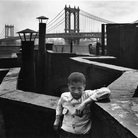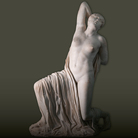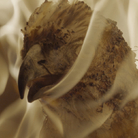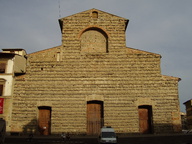Martial Raysse. Futurologia 2015-1958 / 1958-2015

Martial Raysse, Nissa Bella, 1964
Dal 12 April 2015 al 30 November 2015
Venezia
Luogo: Palazzo Grassi
Indirizzo: Campo San Samuele
Orari: 10-19; chiuso martedì
Curatori: Caroline Bourgeois
Costo del biglietto: intero € 15, ridotto € 10, scuole € 6, gratuito under 11
Telefono per informazioni: 199 112 112
E-Mail info: ufficiostampa@palazzograssi.it
Sito ufficiale: http://www.palazzograssi.it/
“Contemporaneo è colui che tiene fisso lo sguardo nel suo tempo, per percepirne non le luci, ma il buio.” Giorgio Agamben
“Il ruolo sociale del pittore? Mostrare la bellezza del mondo per incitare gli uomini a proteggerlo, ed evitare che si dissolva.” Martial Raysse
“Si è detto, a proposito del mio cambio di rotta: ‘Martial torna alla pittura’. È falso. Ci arrivo appena. Di fronte c’è una pagina bianca, la situazione è esattamente la stessa che nel Medioevo. Non è cambiato nulla.” Martial Raysse
2015-1958 / 1958-20145: affrontare la storia a ritroso, non per riavvolgere il filo del tempo e tornare all’inizio, ma piuttosto per mettere a confronto epoche diverse: ecco l’intenzione della mostra che Palazzo Grassi-François Pinault Foundation dedica oggi a Martial Raysse.
L’obiettivo è quello di offrire allo stesso tempo alcune prospettive e una retrospettiva, avvicinandosi al lavoro di Martial Raysse non secondo una scansione cronologica, ma da un punto di vista contemporaneo – a partire cioè dalle sue opere più recenti. È nostra convinzione, in effetti, che i lavori a noi più vicini modifichino il modo in cui osserviamo i precedenti, assicurando una maggiore profondità dello sguardo e rilanciando la questione del ruolo della pittura e di quello dell’artista.
Come afferma acutamente Giorgio Agamben, “Appartiene veramente al suo tempo, è veramente contemporaneo colui che non coincide perfettamente con esso né si adegua alle sue pretese ed è perciò, in questo senso, inattuale; ma, proprio per questo, proprio attraverso questo scarto e questo anacronismo, egli è capace piú degli altri di percepire e afferrare il suo tempo”.
Martial Raysse fa parte di quel ristretto novero di artisti per i quali la vera posta in gioco è il confronto con la “grande” storia dell’arte, e questo fin dall’inizio del suo percorso. Tale confronto può avvenire attraverso la presa di distanza, lo humour o la riproduzione delle opere dei maestri, in virtù del principio enunciato da Eugenio Garin in base al quale “imitare […] è assumere coscienza di sé, […] ritrovare la propria natura”. È così che, nel corso di tutta la vita, Raysse compie il proprio apprendistato, rendendo visibili – sullo sfondo, per così dire – non soltanto la storia dell’arte e i capolavori del Rinascimento, ma anche la banalità del quotidiano, dall’estetica dei Monoprix al tedio delle piccole cose.
Diversamente dagli artisti rinascimentali, che dovevano sottostare ad alcuni vincoli – in particolare nel trattamento di soggetti religiosi o nei ritratti dei committenti – Martial Raysse si è speso, nel corso di una vita intera, per mantenere la propria indipendenza. Sorta di utopia umana, il suo modo di rappresentare la vita di ognuno lascia pensare che l’artista voglia ridarci speranza nella nostra condizione. Il suo amore per la rappresentazione delle donne va al di là dell’attrazione sessuale o della bellezza classica; Raysse è affascinato dalla Sconosciuta.
Nei suoi quadri storici è sempre presente una distanza critica rispetto a ciò che si può vedere o pensare. L’artista dà nuova vita a temi mitologici (pensiamo a L’Enfance de Bacchus o Le Jour des Roses sur le Toit) e per loro tramite parla del consumismo sfrenato, della distanza dalla politica (Poisson d’Avril e Ici Plage), o ancora della volontà di ridere assieme al proprio tempo (Le Carnaval à Périgueux).
Pittore, scultore, disegnatore, ma anche poeta e cineasta… Ognuno di questi termini – per forza di cose riduttivo – cerca invano di definire un artista molteplice e inclassificabile, la cui opera attraversa la seconda metà del XX secolo e continua ancor oggi a sorprenderci con la sua singolarità.
Dando vita a un dialogo ininterrotto tra le opere, il percorso espositivo offre uno sguardo nuovo sull’impegno di Martial Raysse, evidenziando il costante andirivieni dell’artista tra i propri lavori.
L’esposizione rende inoltre visibile l’enorme lavoro sotteso a una tale opera, che – al di là della creazione di “begli oggetti” – mira a proporre una sorta di filosofia della vita. Attraverso la radicalità dei colori, la libertà di elaborazione, Martial Raysse ci fa vedere la bellezza del mondo, la necessità che ciascuno vi trovi il proprio ruolo, la responsabilità del singolo nei confronti degli altri e della comunità.
Nel percorso espositivo abbiamo cercato di mostrare tutti gli aspetti del lavoro dell’artista: le piccole sculture, che spaziano da semplici figure al gioco con se stesso, il disegno come un momento di lavoro, i film, che mostrano le sue pulsioni libertarie, e per finire i quadri, che costituiscono la parte più compiuta della sua opera. Abbiamo inoltre punteggiato il percorso di opere assimilabili, in qualche modo, ad autoritratti capaci di rivelare l’incredibile esigenza e la solitudine che l’artista ha dovuto fare proprie per proseguire nella propria ricerca.
Le opere più recenti illuminano di nuova luce quelle della giovinezza ed espongono la loro radicalità, provocando un vero e proprio choc visivo. L’artista, attraverso l’uso di colori e pigmenti puri, propone uno sguardo altro sul mondo – quell’“igiene della visione” sviluppata fin dagli anni sessanta – e ci insegna a vedere, in quanto “essere moderni significa prima di tutto vederci più chiaro”.
In conclusione, lasciamo la parola all’artista: “Ho sempre pensato che il fine dell’arte fosse cambiare la vita. Ma oggi l’importante, mi sembra, è cambiare ciò che ci circonda a ogni livello dei rapporti umani. C’è chi pensa che la vita debba essere copiata. Altri sanno che va inventata. Rimbaud non si cita, si vive”.
Caroline Bourgeois
“Il ruolo sociale del pittore? Mostrare la bellezza del mondo per incitare gli uomini a proteggerlo, ed evitare che si dissolva.” Martial Raysse
“Si è detto, a proposito del mio cambio di rotta: ‘Martial torna alla pittura’. È falso. Ci arrivo appena. Di fronte c’è una pagina bianca, la situazione è esattamente la stessa che nel Medioevo. Non è cambiato nulla.” Martial Raysse
2015-1958 / 1958-20145: affrontare la storia a ritroso, non per riavvolgere il filo del tempo e tornare all’inizio, ma piuttosto per mettere a confronto epoche diverse: ecco l’intenzione della mostra che Palazzo Grassi-François Pinault Foundation dedica oggi a Martial Raysse.
L’obiettivo è quello di offrire allo stesso tempo alcune prospettive e una retrospettiva, avvicinandosi al lavoro di Martial Raysse non secondo una scansione cronologica, ma da un punto di vista contemporaneo – a partire cioè dalle sue opere più recenti. È nostra convinzione, in effetti, che i lavori a noi più vicini modifichino il modo in cui osserviamo i precedenti, assicurando una maggiore profondità dello sguardo e rilanciando la questione del ruolo della pittura e di quello dell’artista.
Come afferma acutamente Giorgio Agamben, “Appartiene veramente al suo tempo, è veramente contemporaneo colui che non coincide perfettamente con esso né si adegua alle sue pretese ed è perciò, in questo senso, inattuale; ma, proprio per questo, proprio attraverso questo scarto e questo anacronismo, egli è capace piú degli altri di percepire e afferrare il suo tempo”.
Martial Raysse fa parte di quel ristretto novero di artisti per i quali la vera posta in gioco è il confronto con la “grande” storia dell’arte, e questo fin dall’inizio del suo percorso. Tale confronto può avvenire attraverso la presa di distanza, lo humour o la riproduzione delle opere dei maestri, in virtù del principio enunciato da Eugenio Garin in base al quale “imitare […] è assumere coscienza di sé, […] ritrovare la propria natura”. È così che, nel corso di tutta la vita, Raysse compie il proprio apprendistato, rendendo visibili – sullo sfondo, per così dire – non soltanto la storia dell’arte e i capolavori del Rinascimento, ma anche la banalità del quotidiano, dall’estetica dei Monoprix al tedio delle piccole cose.
Diversamente dagli artisti rinascimentali, che dovevano sottostare ad alcuni vincoli – in particolare nel trattamento di soggetti religiosi o nei ritratti dei committenti – Martial Raysse si è speso, nel corso di una vita intera, per mantenere la propria indipendenza. Sorta di utopia umana, il suo modo di rappresentare la vita di ognuno lascia pensare che l’artista voglia ridarci speranza nella nostra condizione. Il suo amore per la rappresentazione delle donne va al di là dell’attrazione sessuale o della bellezza classica; Raysse è affascinato dalla Sconosciuta.
Nei suoi quadri storici è sempre presente una distanza critica rispetto a ciò che si può vedere o pensare. L’artista dà nuova vita a temi mitologici (pensiamo a L’Enfance de Bacchus o Le Jour des Roses sur le Toit) e per loro tramite parla del consumismo sfrenato, della distanza dalla politica (Poisson d’Avril e Ici Plage), o ancora della volontà di ridere assieme al proprio tempo (Le Carnaval à Périgueux).
Pittore, scultore, disegnatore, ma anche poeta e cineasta… Ognuno di questi termini – per forza di cose riduttivo – cerca invano di definire un artista molteplice e inclassificabile, la cui opera attraversa la seconda metà del XX secolo e continua ancor oggi a sorprenderci con la sua singolarità.
Dando vita a un dialogo ininterrotto tra le opere, il percorso espositivo offre uno sguardo nuovo sull’impegno di Martial Raysse, evidenziando il costante andirivieni dell’artista tra i propri lavori.
L’esposizione rende inoltre visibile l’enorme lavoro sotteso a una tale opera, che – al di là della creazione di “begli oggetti” – mira a proporre una sorta di filosofia della vita. Attraverso la radicalità dei colori, la libertà di elaborazione, Martial Raysse ci fa vedere la bellezza del mondo, la necessità che ciascuno vi trovi il proprio ruolo, la responsabilità del singolo nei confronti degli altri e della comunità.
Nel percorso espositivo abbiamo cercato di mostrare tutti gli aspetti del lavoro dell’artista: le piccole sculture, che spaziano da semplici figure al gioco con se stesso, il disegno come un momento di lavoro, i film, che mostrano le sue pulsioni libertarie, e per finire i quadri, che costituiscono la parte più compiuta della sua opera. Abbiamo inoltre punteggiato il percorso di opere assimilabili, in qualche modo, ad autoritratti capaci di rivelare l’incredibile esigenza e la solitudine che l’artista ha dovuto fare proprie per proseguire nella propria ricerca.
Le opere più recenti illuminano di nuova luce quelle della giovinezza ed espongono la loro radicalità, provocando un vero e proprio choc visivo. L’artista, attraverso l’uso di colori e pigmenti puri, propone uno sguardo altro sul mondo – quell’“igiene della visione” sviluppata fin dagli anni sessanta – e ci insegna a vedere, in quanto “essere moderni significa prima di tutto vederci più chiaro”.
In conclusione, lasciamo la parola all’artista: “Ho sempre pensato che il fine dell’arte fosse cambiare la vita. Ma oggi l’importante, mi sembra, è cambiare ciò che ci circonda a ogni livello dei rapporti umani. C’è chi pensa che la vita debba essere copiata. Altri sanno che va inventata. Rimbaud non si cita, si vive”.
Caroline Bourgeois
SCARICA IL COMUNICATO IN PDF
COMMENTI

-
 Dal 2 December 2025 al 19 February 2026
Milano | Centro Culturale di Milano
Dal 2 December 2025 al 19 February 2026
Milano | Centro Culturale di Milano
Walter Rosenblum. Il mondo e la tenerezza
-
 Dal 30 November 2025 al 12 April 2026
Gallarate | Museo MA*GA
Dal 30 November 2025 al 12 April 2026
Gallarate | Museo MA*GA
Kandinsky e l’Italia
-
 Dal 29 November 2025 al 12 April 2026
Roma | Musei Capitolini
Dal 29 November 2025 al 12 April 2026
Roma | Musei Capitolini
La Grecia a Roma
-
 Dal 22 November 2025 al 3 May 2026
Torino | Sale Chiablese dei Musei Reali
Dal 22 November 2025 al 3 May 2026
Torino | Sale Chiablese dei Musei Reali
Orazio Gentileschi. Un pittore in viaggio
-
 Dal 20 November 2025 al 25 January 2026
Firenze | Palazzo Strozzi
Dal 20 November 2025 al 25 January 2026
Firenze | Palazzo Strozzi
Andro Eradze. Bones of Tomorrow
-
 Dal 21 November 2025 al 28 March 2026
Cuneo | Complesso Monumentale di San Francesco
Dal 21 November 2025 al 28 March 2026
Cuneo | Complesso Monumentale di San Francesco
La Galleria Borghese. Da Raffaello a Bernini. Storia di una collezione


